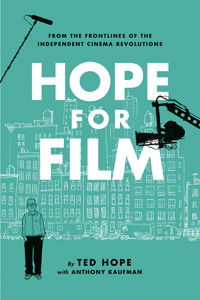[contextly_auto_sidebar id=”u8nyNEUGiw9T3t2MS4otkepc3HaoApPt”]
ONE of the casualties of our current cultural situation is the erosion of the middle — the middle class, the midlist author, the middlebrow, and the mid-budget film. Independent film, with its interest in boundary pushing and risk-taking, may not seem to belong in that company, but it’s vulnerable to all the same forces. The New York Times tells us that Tom Bernard of Sony Pictures Classics recently compared indie film to Petey the Puffin, who, “on a widely watched webcam video, starved to death in Maine before a horrified audience because climate change had disrupted the food chain.” (The environment for indie, that story tells us, may be getting worse, because of a change involving the Toronto Film Festival.)
A more complex but almost as dispiriting tale comes from Ted Hope, an indie producer of legend who helped make many of the films of Hal Hartley, The Ice Storm, Happiness, Todd Haynes’s Safe, and much more. It’ a kind of roller coaster reading this excerpt from Hope’s new book on Soft Skull, Hope For Film .
.
Again and again, his basic optimism and urge to innovate get overcome by events. Generally, his ambition was to make films with “midsized budgets—low enough that you could take creative risks, but high enough that you could compete at the Academy Awards if you delivered the goods.”
At one point, he writes:
Even as I watched my income drop over a four- to five-year period, I didn’t think I needed to do a complete 180-degree
shift. I was still getting good movies made, although there was no denying they were being seen less, having less impact, and were less satisfying, as a result. I was also starting to feel that I wasn’t being realistic about the changes that were coming to the industry. Or perhaps how these changes had already arrived.
And the recession was not as temporary as he’d expected:
The downturn lasted more than three years. And the indie world wasn’t changing for the better; it actually got harder to finance or sell those films. And yet, it was becoming easier, at least on a technical level, to make interesting movies on increasingly smaller budgets.The optimist in me believed that both the indie-film culture and the indie business would bounce back, that this was just a blip caused by the economic crisis and that people (and the industry) would again hunger for quality tales told well. So I set myself a three-year goal of trying to make five films, regardless of budget, provided at least two had a budget of at least three million dollars so that I could earn enough to support myself and an assistant.
One of the the things I like about Hope’s assessment is the way he looks — to use the metaphor I started this discussion with — at the larger ecology, in this case the sustenance provided by journalistic criticism. Here is he again:
People trust the people they’re closest to.That’s the great crime in the firing of so many film critics in America over the last few years. Local audiences trusted those local critics; after years of engagement, the critics had developed a relationship with their audience, which came to know when to take something with a grain of salt and when to follow their advice like a close friend. Those critics may blog, but blogging does not have the same authority as when they were the voice of their local community.
We’re eager to see Hope’s book, which sounds like it has some concerns in common with (shameless plug ahead) our own Culture Crash.
